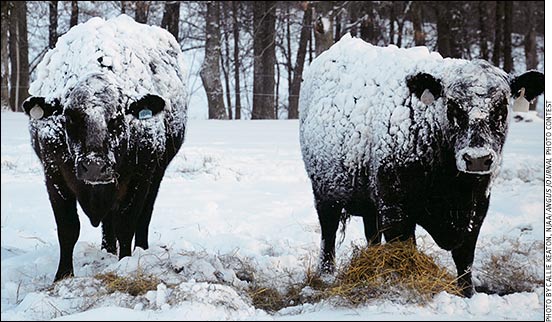
Winter Cow Management
Pay attention to nutritional needs.
According to Shannon Williams, Lemhi County Extension Agent in Salmon, Idaho, the most important thing in winter cow management is to make sure you are meeting your cows’ nutritional requirements according to where they are in their gestational stage.
Dick Fredrickson, veterinarian and nutritionist for Simplot, Grandview, Idaho, says, “Assuming cows have adequate energy from forage, the next important thing is mineral supplementation — which is critical for digestion of forage.”
Salt should always be provided, since this is the mineral most lacking in forages. In many geographic locations, forage may also be lacking in copper, selenium or zinc. Know the mineral content of your forages, and provide supplements via a salt-mineral mix, bolus or injectable product if levels are low. Trace mineral status of the cow affects all aspects of reproduction and production, as well as the future well-being of her calf.
In a drought, grass may be short on protein and phosphorus. As a general rule, rangeland grasses hold their feed values better through winter than “tame” or irrigated pastures, or crop residues. These lose nutrient value once they dry up or freeze, and cattle generally need supplemental feed such hay, silage, grain or a protein supplement and mineral mix to complement that type of forage.
If pasture is gone or snowed under and you’re feeding hay, having cattle in several groups is best because their needs are different.
“You don’t want to ‘waste’ hay by feeding better-quality feed than they need,” Williams says. “Cows in early or mid-gestation don’t need your best hay. Save it for later (when they need it in late gestation or for lactation) or feed it to heifers and 2-year-olds.
“The only way to truly know the nutritional value of hay is to have it analyzed in a lab, he continues. “I’ve seen some ‘ugly’ hay that’s high in protein, and some hay with great color that had very little protein.”
Weaned calves need the highest-quality feed. Next would be pregnant heifers and 2-year-olds that just weaned calves. For the 2-year-old, winter is a critical time, notes Williams. These young cows are still growing; may be pulled down in body condition while nursing their first calf; and are pregnant again. If they go into winter thin, they need to catch up in body condition so they can give birth to healthy calves and rebreed on time.
Mature, dry cows can get by on lesser-quality forage, whether pasture or hay, until late gestation. They don’t need as much protein or energy because they’re not growing or needing to gain weight. If cattle are in separate groups, you can feed the young or thin ones for growth/weight gain without overfeeding the whole herd. Feeding all cattle the same ration (or using up your best pastures too soon with the whole herd) can be costly. Young/thin ones may not get as much as they need; older, bossier cows tend to eat more than their share of any hay or protein supplement.
“Adequate protein is crucial during the last 60 days of pregnancy for development of the unborn calf and for the cow’s formulation of colostrum,” says Fredrickson. “Timely vaccination with a scour-prevention vaccine needs to be administered at this time, also, if scours are a problem in the herd,” he says.

Editor’s Note: Heather Smith Thomas is a cattlewoman and freelance writer from Salmon, Idaho.





